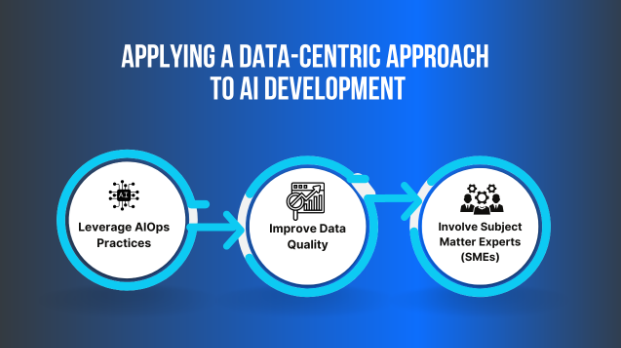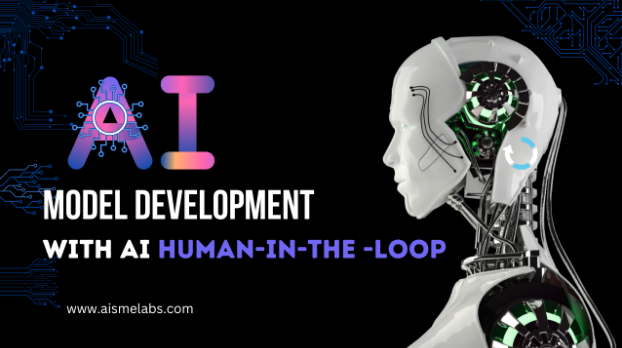Over the last few years, artificial intelligence has gone through significant advancements to improve the accuracy and effectiveness of models and enable automation to benefit humans. A survey at Mckinsey shows that AI adoption has more than doubled since 2017.
However, AI model development is not only a technical endeavor; it requires collaboration between data, AI, and subject matter experts (SMEs) to ensure that the models are accurate and relevant to their intended domain.
Across AI model development, data and human knowledge are imperative to conduct tasks with high performance and ensure accuracy and model success. This gives rise to a new class of AI technology, Data-Centric AI, that focuses on understanding, utilizing, and making data-focused decisions.
The article explores data-centric AI, its benefit over model-centric AI, and how it encourages collaboration of data, AI, and SMEs.
Data-Centric AI: The Collaboration of Data, AI & SMEs
Data-centric AI is an approach to AI model development focused on data instead of the model to improve the performance of AI systems. The approach requires subject matter experts as an integral part of the development process. It focuses on improving data quality and system performance by iterating data. Also, it takes data collection, annotation, and training data preparation as an ongoing process that continues even after the AI models are deployed.

Data-centric AI is designed to work with data and make improved predictions after learning from it. It has become increasingly popular due to its potential benefits of improving decision-making. For example, businesses can use data-centric AI to make better decisions about their products and services; for instance, it can help businesses understand their customer usage data and work on the improvement of their VoIP phone services.
How Does It Work?
Since data-centric AI is all about improving data quality and AI development, teams spend more time labeling, screening, and scaling data to ensure successful outcomes. It works by focusing on three key principles, which include.
Training data quality:
The quality of training data is critical to enable improved advances in AI development. It ensures the algorithms are accurate and can mitigate any potential bias in an AI project.
Scalable strategies:
A data-centric approach to AI focuses on adopting scalable strategies that can address the need for a large amount of training data needed for deep learning models and the difficulty in searching for labels in real-world environments manually and iteratively.
Subject matter experts (SMEs):
As mentioned earlier, data-centric AI requires SMEs in AI model development, as they can help label and manage data and oversee data quality over time.
Data-Centric AI vs. Model-Centric AI
Unlike model-centric AI, data-centric AI focuses on getting the right data to build high-quality, high-performance AI/ML models. Whereas model-centric AI focuses on code and treating data collection as on-time data, neglecting the importance of data.
Over the last decade, AI model development has been focused on model-centric development, enabling the development of model architecture, such as neural networks. The approach involves solving data issues such as noise and inaccurate labels by collecting large data sets and optimizing the model to make the model perform better. While the model-centric approach also involves data cleaning, it is often limited.
Data-centric AI | Model-centric AI |
Main focus is on improving data quality. | Focuses on improving model parameters. |
Improving data quality by working on noisy data. | You optimize the model to deal with data noise. |
Achieving high data consistency. | You assume inconsistent data labels may average out if the model is good. |
Iterations to improve data quality and coverage. | Iterations improve model parameters. |
Data-centric AI aims to improve data rather than the model architecture by using high-quality data labels, collecting complete and representative data, and minimizing data bias with the help of SMEs.
Example of Collaboration of Data, AI & Human
Yokohama’s HAICoLab is an example of how artificial intelligence and big data, in collaboration with human guidance, helped achieve this innovation. Humans and AI collaborate for digital innovation; HAICoLab is Yokohama’s solution to improve tire structure, design, and on-road performance.
HAICoLab creates and collects large amounts of data from measurements and simulations, then predicts improvements based on hypothetical conditions set by humans. The platform is intended to enable collaboration between humans and AI that unlocks their full potential to achieve outcomes.
Applying a Data-Centric Approach to AI Development
Combining the strength of human strategic reasoning with the computational power of machines can develop a powerful human-machine bond that will not only generate better ideas for solving highly complex problems but also enable innovation.
“The human does the strategy, the machine does the tactics, and when you put them together, you get a world-beater.” ~ Sandy Pentland, MIT Media Lab
Let’s discuss how you can apply a data-centric approach to AI development.

Leverage AIOps Practices
A data-centric approach to AI model development is focused on data quality rather than the model itself. It includes model selection, hyperparameter optimization, experiment tracking, and model deployment and monitoring. You can automate the process to streamline AI lifecycle processes. Companies should adopt AIOps practices to standardize and automate model-building and related processes. However, human oversight is necessary to ensure accuracy.
Improve Data Quality
Improving data quality is critical in data-centric AI. You can use tools and techniques to improve the quality of data. To improve data quality, ensure;
Quality of data labels:
Since labels provide information about data context, it is necessary to label data properly. Improve the quality of data labels, as inaccurate labels can provide incorrect information to the algorithm.
Unbiased data:
If the data used to train AI models were biased, the outcome of the models would also reflect biases. Make sure AI model development doesn’t involve bias in its processes, from data collection to labeling.
Involve Subject Matter Experts (SMEs)
In data-centric AI, involving human expertise while creating datasets is essential. Human intervention in AI model development is necessary to inspect, validate, and modify algorithms to improve data quality and outcomes. SMEs can collect, label, and conduct quality control on data and improve model accuracy, transparency, and quality of predictions.
Get SMEs Expertise to Thrive in the Age of Data and AI
The collaboration of AI, data, and humans is essential for driving innovation and growth in today’s business landscape. At AISME Labs, we understand the importance of this dynamic and strive to provide our clients with the best AI+SME services to help them achieve their goals. We believe that by harnessing the power of AI and data, and working together with humans, we can unlock new opportunities and drive progress in all industries.
Moreover, we host a diverse network of SMEs that can provide you with the knowledge to help you plan your AI strategy, build AI models, and manage AI services. Learn more about our services and request a free assessment to engage with highly-qualified professionals for your next AI project.





